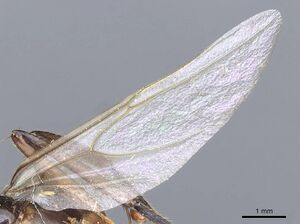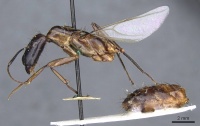Camponotus longipilis
| Camponotus longipilis | |
|---|---|

| |
| Scientific classification | |
| Kingdom: | Animalia |
| Phylum: | Arthropoda |
| Class: | Insecta |
| Order: | Hymenoptera |
| Family: | Formicidae |
| Subfamily: | Formicinae |
| Tribe: | Camponotini |
| Genus: | Camponotus |
| Species: | C. longipilis |
| Binomial name | |
| Camponotus longipilis Emery, 1911 | |
This species colonizes stems of live bamboo (Guadua) in Amazonia and are specialized on this nesting habitat. Large numbers of coccids (Cryptostigma guadua) occur inside the bamboo nests (Kondo & Gullan 2004, Davidson et al. 2006) and appear to be a major source of nourishment for the ants.
| At a Glance | • Bamboo Specialist |
Identification
A member of the subgenus Myrmostenus.
Mackay (1997) - This species has an elongate head (CI 54-56) which is basically rectangularly shaped. It is identical to that of Camponotus postangulatus, except it lacks the occipital angles. The ventral surface of the head is covered with dense, long, erect, twisted hairs. The occipital corners are rounded and not angulate.
This species would not be confused with any other in the longipilis complex, except C. postangulatus. It differs in that the occipital corners are not angulate and the ventral surface of the head is covered with long, coarse, erect hairs. The sculpture is similar to that of C. leptocephalus, but it lacks the abundant hairs on the dorsum of the head, having only a few scattered, coarse, erect hairs. The clypeal carina is also much more differentiated than it is in C. leptocephalus.
Keys including this Species
Distribution
Latitudinal Distribution Pattern
Latitudinal Range: -11.9° to -12.85291667°.
| North Temperate |
North Subtropical |
Tropical | South Subtropical |
South Temperate |
- Source: AntMaps
Distribution based on Regional Taxon Lists
Neotropical Region: Bolivia, Peru (type locality).
Distribution based on AntMaps
Distribution based on AntWeb specimens
Check data from AntWeb
Countries Occupied
| Number of countries occupied by this species based on AntWiki Regional Taxon Lists. In general, fewer countries occupied indicates a narrower range, while more countries indicates a more widespread species. |

|
Estimated Abundance
| Relative abundance based on number of AntMaps records per species (this species within the purple bar). Fewer records (to the left) indicates a less abundant/encountered species while more records (to the right) indicates more abundant/encountered species. |

|
Biology
Colonies are polydomous. Established colonies grow and occupy multiple culms after workers open entrances in young Guadua stems prior to lignification. After culm walls have lignified, they do not appear to be able to open entryways to unbreached internodes, and both live and dead bamboo specialists apparently depend either on entrances cut by other arthropods, or on cracks and fissures in fractured stems. (Davidson et al. 2006)
Apparently invaded by Camponotus mirabilis
Castes
Images from AntWeb

| |
| Lectotype of Camponotus longipilis. Queen (alate/dealate). Specimen code casent0905508. Photographer Z. Lieberman, uploaded by California Academy of Sciences. | Owned by MSNG, Genoa, Italy. |
Nomenclature
The following information is derived from Barry Bolton's Online Catalogue of the Ants of the World.
- longipilis. Camponotus longipilis Emery, 1911a: 224 (q.) PERU.
- Type-material: lectotype queen (by designation of Mackay, 1997: 200).
- [Note: original description cites 2q syntypes.]
- Type-locality: Peru: Pachitea (no collector’s name) (from Staudinger & Bang-Haas).
- Type-depository: MSNG.
- Combination in C. (Myrmamblys): Forel, 1914a: 271;
- combination in C. (Myrmostenus): Emery, 1920b: 260.
- Status as species: Emery, 1925b: 161; Kempf, 1972a: 59; Bolton, 1995b: 109; Mackay, 1997: 200 (redescription); Bezděčková, et al. 2015: 112.
- Distribution: Bolivia, Peru.
Unless otherwise noted the text for the remainder of this section is reported from the publication that includes the original description.
Description
Queen
Mackay (1997) - HL 3.44-3.58, HW 1.88-1.94, SL 2.68-2.88, EL 0.73-0.79, clypeal length 1.23-1.32, clypeal width 0.91-1.02. Indices: SI 78-84, CI 54-56, clypeal index 74-77.
Mandible with 6 teeth; clypeus longer than broad, widened anteriorly, surface strongly convex with well-defined carina; clypeal border strongly concave; scape extending past posterior border of head; vertex weakly convex; maxillary palps short and delicate, extending about half distance to foramen magnum; labial palps also slender and about ½ length of maxillary palps; descending face of propodeum somewhat more than 1/2 length of basal face; petiole with strongly convex anterior face, straight posterior face.
Hairs erect, sparse, long and coarse on head (including underside of head), scattered on mesosoma and scattered on gaster; decumbent pubescence very fine and sparse on mesosoma and gaster. Head weakly, but densely punctate, mesosoma and gaster coriaceous, but strongly shining.
Color medium brown, head, mandibles and scape darker brown.
Type Material
Mackay (1997) - Lectotype queen (here designated), Pachita, Peru, Stdg; longipilis Emery (Museo Civico di Storia Naturale, Genoa) [seen]; second female mentioned by Emery (1911) not seen.
References
- Davidson, D.W., Arias, J.A., Mann, J. 2006. An experimental study of bamboo ants in western Amazonia. Insectes Sociaux 53, 108–114.
- Emery, C. 1911d. Fragments myrmécologiques. Ann. Soc. Entomol. Belg. 55: 213-225 (page 224, queen described)
- Emery, C. 1920b. Le genre Camponotus Mayr. Nouvel essai de la subdivision en sous-genres. Rev. Zool. Afr. (Bruss.) 8: 229-260 (page 260, Combination in C. (Myrmostenus))
- Forel, A. 1914a. Le genre Camponotus Mayr et les genres voisins. Rev. Suisse Zool. 22: 257-276 (page 271, Combination in C. (Myrmamblys))
- Kondo T & Gullan PJ 2004. A new species of ant-tended Soft Scale of the genus Cryptostigma Ferris (Hemiptera: Coccidae) associated with bamboo in Peru. Neotropical Entomology 33(6):717-723.
- Mackay, W.P. 1997. A revision of the Neotropical ants of the genus Camponotus, subgenus Myrmostenus. Proceedings of the Entomological Society of Washington. 99:194-203.
References based on Global Ant Biodiversity Informatics
- Davidson D. W., S. C. Cook, R. R. Snelling and T. H. Chua. 2003. Explaining the Abundance of Ants in Lowland Tropical Rainforest Canopies. Science 300: 969-972.
- Davidson, D.W., J.A. Arias and J. Mann. 2006. An experimental study of bamboo ants in western Amazonia. Insectes Sociaux 53:108114.
- Emery C. 1911. Fragments myrmécologiques. Annales de la Société Entomologique de Belgique 55: 213-225.
- Fernández, F. and S. Sendoya. 2004. Lista de las hormigas neotropicales. Biota Colombiana Volume 5, Number 1.
- MacKay W. P. 1997. A revision of the Neotropical ants of the genus Camponotus, subgenus Myrmostenus (Hymenoptera: Formicidae). Proceedings of the Entomological Society of Washington 99: 194-203.

